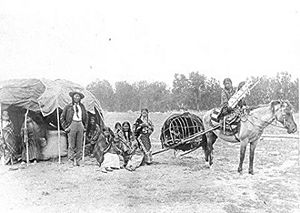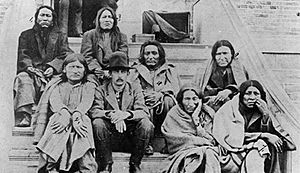Northern Cheyenne Exodus facts for kids
Quick facts for kids Northern Cheyenne Exodus |
|||||||
|---|---|---|---|---|---|---|---|
| Part of the American Indian Wars | |||||||
 Little Wolf and Dull Knife, Chiefs of the Northern Cheyenne |
|||||||
|
|||||||
| Belligerents | |||||||
| Northern Cheyenne | |||||||
| Commanders and leaders | |||||||
| Dull Knife Little Wolf Wild Hog Left Hand (killed in action) Little Finger Nail (killed in action) |
|||||||
| Strength | |||||||
| 297 people | ~1,000 soldiers and civilians | ||||||
| Casualties and losses | |||||||
| ~50 killed, ~30 wounded, ~70 captured | ~30 killed, ~20 wounded | ||||||
|
|||||||
The Northern Cheyenne Exodus was a brave journey made by the Northern Cheyenne people. They tried to return to their homeland in the north. This happened after they were forced to move to a reservation far south in the Indian Territory. The United States Army tried to stop them during this time, which lasted from 1878 to 1879. This event is also known by other names, like Dull Knife's Raid or the Cheyenne War.
Contents
Why the Cheyenne Left Their Home
After a big battle called the Battle of the Little Bighorn, the U.S. Army worked harder to control the Northern Cheyenne. In 1877, some Cheyenne chiefs, like Dull Knife and Little Wolf, surrendered at Fort Robinson. They expected to live on a reservation with the Sioux people. This was part of a treaty they had signed in 1868 at Fort Laramie.
However, things did not go as planned. Soon after arriving at Fort Robinson, the government decided the Northern Cheyenne should move. They were sent to a reservation at Fort Reno with the Southern Cheyenne. This was a big change for them.
Life on the Southern Reservation
The Cheyenne began their long journey south with nearly 1,000 people. By the time they reached the Cheyenne-Arapaho reservation in August 1877, some had died, and a few young men had secretly gone back north.
Life on the new reservation was very hard. The Northern Cheyenne found it was very poor, and many people became sick in late 1877. The government looked into the problems, but conditions did not get better. The Cheyenne were given permission to hunt for food.
However, when they went to hunt, they found almost no game. The land was full of dead buffalo. The U.S. Army had allowed and even encouraged the killing of buffalo herds. This was done to remove the main food source for Native American people. It was a way to pressure them onto reservations during conflicts.
The winter of 1877–78 was very difficult. In 1878, a measles outbreak hit the Northern Cheyenne, making many more people sick. By August 1878, the Cheyenne chiefs decided they had to leave. On September 9, 1878, Little Wolf, Dull Knife, Wild Hog, and Left Hand told their people to get ready. About 297 men, women, and children began their journey north.
The Journey North Begins
In the early morning of September 10, the Cheyenne group quietly left the reservation. They traveled up the North Canadian River. By 3 AM, the army realized they were gone and began to chase them.
The Cheyenne passed through areas that are now Watonga, Oklahoma and Canton, Oklahoma. They crossed into the Cimarron Basin and then the Cimarron River that same evening. Near what is now Freedom, Oklahoma, they rested briefly. Then they continued to Turkey Springs. After a short rest there, Dull Knife led the women and children to St. Jacob's Well and The Big Basin in Clark County, Kansas, where they camped.
Preparing for Battle at Turkey Creek
The Cheyenne knew the army would follow them. So, they set up an ambush at Turkey Springs. Some warriors dug rifle pits, while others spread out to find supplies. They managed to get two mules by attacking cowboys. In another encounter, they got food and a rifle from some cowboys during their breakfast.
Battle of Punished Woman's Fork
| Battle of Punished Woman's Fork | |||||||
|---|---|---|---|---|---|---|---|
| Part of Northern Cheyenne Exodus | |||||||
|
|||||||
| Belligerents | |||||||
| Northern Cheyenne | United States | ||||||
| Commanders and leaders | |||||||
| Dull Knife Little Wolf | Ltc William H. Lewis † | ||||||
After crossing the Arkansas River, the Cheyenne were closely followed by U.S. soldiers. On September 27, the Cheyenne tried to set up an ambush in a canyon on Punished Woman's Fork. This is north of today's Scott City, Kansas. However, the ambush was spoiled when a warrior fired too early.
In the Battle of Punished Woman's Fork, the soldiers attacked. They tried to trap the Cheyenne and their families in the canyon. But the Cheyenne were skilled fighters. The American commander, Lieutenant Colonel William H. Lewis, was shot in the leg. This caused confusion among the soldiers. The Cheyenne used this chance to escape after dark. Lewis died the next day. The Cheyenne lost many horses, baggage, and all their food during the battle.
Hard Times in Kansas
After the battle, the Cheyenne were desperate for food and supplies. Between September 30 and October 3, 1878, small groups of Cheyenne searched for horses, cattle, and supplies in northwestern Kansas. They encountered isolated settlers, some of whom had never seen Native Americans before.
People were killed during these encounters. Sometimes, the Cheyenne would approach settlers in a friendly way before attacking. These actions were likely due to the Cheyenne losing their food and horses at Punished Woman's Fork. This created a crisis for the fleeing people. Also, some elderly or injured Cheyenne who could not keep up were killed by white groups.
The Chase Continues to Nebraska
From Turkey Creek, the journey became a running battle across Kansas and Nebraska. Soldiers from many forts chased the Cheyenne day and night. About ten thousand soldiers and three thousand settlers were involved in the pursuit. In the last two weeks of September, the army caught up to the Cheyenne five times. But the Cheyenne managed to escape each time by traveling through difficult terrain. This made it hard for the army to follow.

The Cheyenne Groups Separate
In the fall of 1878, after six weeks of constant travel, the Cheyenne chiefs held a meeting. They realized that 34 people were missing from their original group. Most had been killed, but a few had chosen different paths north. At this point, the Cheyenne decided to split into two groups.
One group, led by Dull Knife, Wild Hog, and Left Hand, wanted to stop running. They decided to go to the Red Cloud Agency. The other group, led by Little Wolf, continued north. He intended to reach the Powder River country.
Dull Knife's Group at Fort Robinson
On October 23, 1878, Dull Knife's group was only two days away from Fort Robinson when the Army surrounded them. Dull Knife decided to go to Fort Robinson because of the bad weather and his people's poor condition. That night, the Cheyenne cleverly took apart their best guns. The women hid the gun barrels under their clothes, and smaller pieces were attached to clothes and moccasins as decorations.
On October 25, 1878, Dull Knife, Left Hand, Wild Hog, and the rest of their group finally reached Fort Robinson. The barracks, built for 75 soldiers, now held 150 Cheyenne people.
In December, Red Cloud came to Fort Robinson to talk with Dull Knife and the other chiefs. Dull Knife agreed to stop fighting if the government would let his people live on the Pine Ridge Indian Reservation. This was where Red Cloud and his tribe were now living. However, on January 3, 1879, the Cheyenne were ordered to return south to the Southern Cheyenne reservation. When they refused, the soldiers put bars on the windows and stopped giving them food and wood for heat.

On January 9, 1879, Dull Knife still refused to go south. Wild Hog and Left Hand agreed to talk, but they also said their people would not move. As a result, Wild Hog was taken prisoner and put in chains. At 9:45 that night, the Cheyenne tried a daring escape using the guns they had hidden. The soldiers immediately followed them, and many Cheyenne were killed in what became known as the Fort Robinson breakout.
By morning, 65 Cheyenne, including 23 who were wounded, were brought back to Fort Robinson as prisoners. Only 38 Cheyenne managed to escape and stay free. Thirty-two of them traveled north together, still chased by the Army. Six Cheyenne hid near the fort and were found in the next few days. At the Hat Creek Bluffs, 32 Cheyenne, led by Little Finger Nail, were trapped. After a final battle, only nine were left alive.
In January 1879, Dull Knife reached Pine Ridge, where Red Cloud was being held. After many delays from Washington, the prisoners from Fort Robinson were finally released. They were allowed to go to Fort Keogh, where Little Wolf's group had ended up.
Little Wolf's Group Continues North
After the Cheyenne split near the North Platte River, Little Wolf's group continued north. They spent the winter in the Sand Hills of Nebraska, along Wild Chokecherry Creek. There was plenty of deer, antelope, and cattle. They saw a few white men during the winter but were not bothered.
In early spring, they moved north to the Powder River. There, scouts from Fort Keogh found them. These scouts were part of a group led by Lieutenant W. P. Clark, an army officer known as White Hat to the Cheyenne. Clark had been friendly with Little Wolf in the past. After talking with the scouts and then with Lieutenant Clark, Little Wolf's group agreed to surrender. They went with the soldiers to Fort Keogh. There, they were offered a chance to serve in the army as scouts. After some discussion, Little Wolf and Red Armed Panther agreed to become scouts.
A New Home: Northern Cheyenne Reservation
After some time, the Northern Cheyenne Indian Reservation was created in southeastern Montana, near the Black Hills. The Northern Cheyenne were finally allowed to stay in the north and were never forced to return to the south again.


